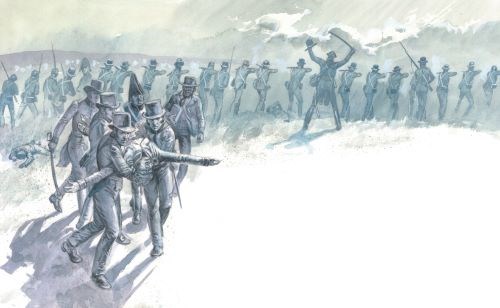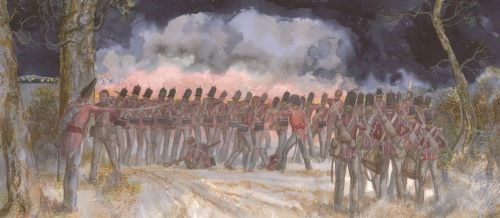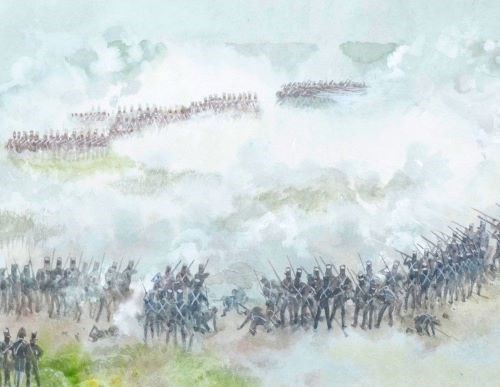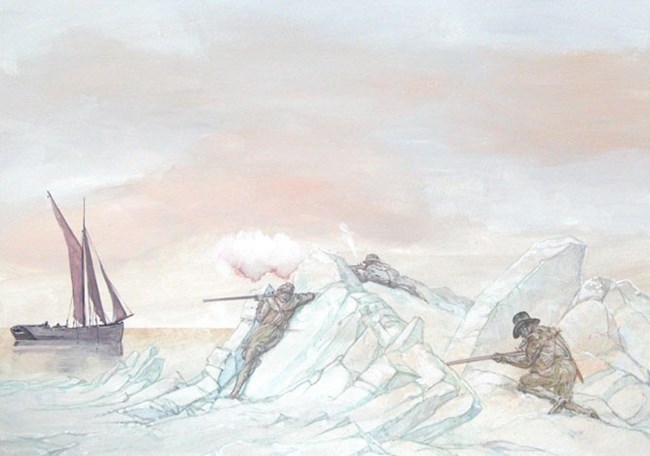|
Because the British targeted Washington and Baltimore on the Chesapeake Bay’s western shore, the role of Maryland’s Eastern Shore in the War of 1812 often is overlooked, despite being the location for two battles, seven skirmishes, and at least 14 British raids.

Caulks FieldKent County braced for the return of the British in August 1814. Enemy raiders had destroyed nearby Georgetown the previous year while terrorizing Maryland’s Eastern Shore. Now they were back in an attempt to divert attention from their main operation against Baltimore. They landed on August 30, and marched inland to encounter the American militia at the Isaac Caulk farm. The Americans stood their ground during the night attack. Heavy British casualties included a popular young officer, Captain Sir Peter Parker. The victory in the Battle of Caulk’s Field boosted American morale following the enemy’s invasion of Washington, D.C. EastonEaston expected to be a British target during the War of 1812. A two-story brick armory in the center of town housed cannon, small arms, and military stores to serve all of Maryland’s Eastern Shore. Fort Stoakes, an earthworks built to protect Easton from a waterside attack, reportedly accommodated 500 men. Two armed barges on the Tred Avon River provided additional security. British raiders terrorized the Eastern Shore in 1813 and 1814. Queenstown, St. Michaels, Fredericktown, and Georgetown were attacked, plus numerous farms and plantations were plundered. However, Fort Stoakes was never tested, and Easton survived unscathed. Kent IslandKent Island served as an ideal base of operations for the British in August 1813, as it was already an important link between Maryland’s eastern and western shores. The British took over the Kent Island— Annapolis ferry, including a cargo of cattle, and used the ferry landing as one of several encampments. As many as 3,000 British troops conducted raids along the middle Bay from Kent Island. As part of a strategy to disrupt the American economy, the British offered freedom to slaves who escaped their masters and joined the British. More than 150 slaves came from the Eastern Shore. The British destroyed many Kent Island plantations in the short time they held the island. Rock HallBritish Captain Peter Parker arrived at Rock Hall in the HMS Menelaus August 20, 1814. The British had terrorized towns in the Upper Bay all summer, but Parker came with a special mission—to divert attention from a strike against the U.S. Capital. While Parker raided Rock Hall, the main British force began its march to Washington from Southern Maryland. Parker’s squadron was still anchored off Rock Hall August 25 when the fierce storm that doused the smoldering Capitol Building and White House wreaked havoc across the Bay. The British lost a supply of weapons when the vessel Mary capsized at Swan Point. 
Queenstown and the Battle of Slippery HillThe British set out from Kent Island to attack Queenstown on August 13, 1813. The land and water contingents numbered 300 troops each. Intending to surprise the Queen Anne’s County militia, they mistakenly fired, warning the Americans. British barges missed their intended landing point at Bowlingly, arriving at Blakeford instead. These errors enabled the militia to escape to Centreville. The British retaliated by ransacking Bowlingly, a prominent home in Queenstown. The skirmish that foiled the surprise became known as the Battle of Slippery Hill. British and Americans exchanged fire on Queenstown Road. An American militiaman shot the horse out from under British commanding officer Sir Sydney Beckwith, escalating the confusion among the British ranks. 

Taylors Island and the Battle of the Ice MoundLocal militia attacked a British raiding party whose vessel was icebound near James Island February 7, 1815. Protected by a breastwork of ice, the Americans continued firing until the crew of 20 surrendered. The two-hour skirmish, the “Battle of the Ice Mound,” was the last engagement of the war in Maryland. Ratification of a peace treaty occurred 10 days later. The victorious militia took the British crew as prisoners and confiscated the boat, a 12-pounder carronade, and other weapons. Later the militiamen shared $1800, awarded by Congress for capturing an enemy vessel. Tilghman and Poplar IslandsThe British overtook Tilghman and Poplar islands in the spring of 1813 and again in October 1814. The islands offered ready-access to Annapolis, Baltimore, and other potential targets. A regiment of a thousand men began building winter barracks on Tilghman in 1814, but within the month the British troops were gone. Turners Creek
On May 6, 1813, the British landed barges at Turner’s Creek—a village of about 60 people and an active port for grains and flour. Resident John Stavely was forced to lead the enemy vessels to Fredericktown and Georgetown. After destroying those towns, the British returned to Turner’s Creek. They released Stavely unharmed, obtained supplies, and left peacefully. The British claimed they paid the owners “full value” for supplies obtained at Turner’s Creek. Worton Creek
In raids along the Eastern seaboard and the Chesapeake Bay, the British used barges to maneuver into coastal towns. In April 1813, during a surge of British attackson the Eastern Shore, a sizable force anchored off Worton Creek and conducted raids at nearby Plum Point, Still Pond, and Howell Point. |
Last updated: June 2, 2020
